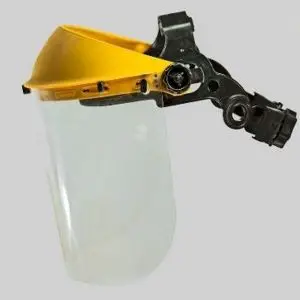A dielectric face shield is an important piece of personal protective equipment that is used to protect your face from electrical hazards. But what industries use these types of face shields? We discuss this below.
What are dielectric face shields?
A dielectric face shield is a special type of face shield that is made from a material known as a dielectric. This material is electrically insulating, meaning that it does not conduct electricity. This makes dielectric face shields ideal for use in applications where there is a risk of electrical shocks, such as when working with high-voltage equipment.
Dielectric face shields are available in a variety of styles, including full-face shields and visors. They can also be worn over regular safety glasses or goggles to provide an extra layer of protection.
Most dielectric face shields are clear, but some models are available with tinted lenses to reduce glare. Face shields made from dielectric materials are typically priced higher than those made from other materials, such as polycarbonate.
What are they used for?
Dielectric face shields are designed to protect the wearer’s face from electrical hazards. They are made of a non-conductive material, such as plastic, and have a dielectric constant that is greater than that of air. This makes them effective at preventing electrical current from passing through to the wearer’s skin.
Dielectric face shields are used in many industries, including electrical work, welding, and medical applications. These include workers who are exposed to electrical hazards, such as electricians, line workers, and power plant operators. They are also worn by workers who work with or around energized equipment, such as circuit breakers and switchgear.
How do they work?
Dielectric face shields are made from electrically insulating materials, such as polycarbonate, that do not conduct electricity. This makes them an effective barrier against electrical hazards.
Electric shock can occur when the body comes into contact with an electrical source, such as an energized conductor or an electrical arc. Electric shock can cause burns, muscular contractions, or even death. Wearing a dielectric face shield reduces the risk of electric shock by providing a barrier between the worker’s face and the electrical hazard.
What are the benefits of using a dielectric face shield?
There are many benefits of using a dielectric face shield in addition to the protection it provides from electrical arc flash hazards. Dielectric face shields are made from a variety of materials, including polycarbonate, lens, and acetate. They are available in different styles, such as full-face shields, Browgard shields, and trivex lenses.
Dielectric face shields are lighter and more comfortable to wear than metal helmets. They also provide better visibility and allow for more air circulation, which can help reduce fogging. In addition, dielectric face shields don’t conduct electricity, so they won’t intensify an electrical arc hazard.
Are there any drawbacks to using a dielectric face shield?
Although dielectric face shields offer a high level of protection, they are not without their drawbacks. One issue is that they can fog up more easily than other types of face shields. This can be a problem in certain work environments, such as when working with hot liquids or in humid conditions.
Another potential drawback is that dielectric face shields can be more expensive than other types of face shields. However, this cost difference is typically offset by the increased level of protection offered by dielectric face shields.
How do you choose the right dielectric face shield for your needs?
When working with or around electricity, one of the most important pieces of personal protective equipment (PPE) you can wear is a dielectric face shield. Dielectric face shields provide protection from arc flash, which is a type of electrical explosion that can occur when work is being done on or around live electrical components.
There are a few different things to consider when choosing the right dielectric face shield for your needs, including the following:
- The voltage of the equipment you will be working on or around
- The type of arc flash hazard you will be exposed to
- The level of protection you need
- The size and weight of the shield
- The clarity of the shield
- Your personal preferences
Once you have considered all of these factors, you will be able to narrow down your choices and select the best dielectric face shield for your needs.
How do you care for your dielectric face shield?
Proper care of your dielectric face shield is essential to maintaining its effectiveness. Here are some tips:
- Rinse the face shield in clean water after each use.
- Remove any dirt or debris with a soft cloth.
- DO NOT use cleaners or chemicals on the face shield.
- DO NOT store the face shield in direct sunlight or in a humid environment.
- Store the face shield in a cool, dry place when not in use.
Dielectric face shields FAQs
Q: What is a dielectric face shield used for?
A: A dielectric face shield is used to protect the wearer’s face from electrical arc flash hazards.
Q: How does a dielectric face shield work?
A: A dielectric face shield is made of a non-conductive material that protects the wearer from electrical arc flash by acting as a barrier between the arc and the wearer’s face.
Q: What are the benefits of using a dielectric face shield?
A: Dielectric face shields offer several benefits, including protection from arc flash hazards, CE-EN166-compliant eye protection, and ANSI Z87.1+ high-impact resistance.
In Closing
Dialectric face shields are made of a non-conductive material that helps to insulate you from electric shocks. This type of face shield is typically worn by electrical workers, linemen, and other professionals who work with or around high-voltage equipment.
NEXT UP: What Are Face Shields Made Of?

